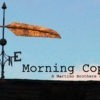A Report from the 2000 New England Film & Video Festival
Written by Julie Wolf | Posted by: Anonymous
While the films and videos presented throughout the Festival, which ran from March 30 through April 4, were of consistently high quality, from the quirky to the sublime, there were unfortunately technical difficulties on the best-attended Awards Night screening (a broken 16mm projector resulted in most films being shown on video, with barely audible sound) and the awkward decision to call the first five minutes of longer films "excerpts." Since they were not edited as excerpts, the tape turned off abruptly in mid-scene or -sentence, whenever and wherever time happened to run out.
Glitches and delays aside, the Festival was a success based on the strength of the entries. Most intriguing about these entries was that they not only gave the audience a glimpse into the future of film, but that many of them catered to, in form as much as in content, the public’s seemingly insatiable appetite for witnessing private pain in a public forum. A recent flood of confessional memoirs (Mary Karr’s The Liars Club and Kathryn Harrison’s notorious The Kiss among them) has made a hot topic of the question, where is the line between public and private, and does it even exist anymore? Judging from the documentaries shown, this debate is about to be played out in movie houses as well.
Documentaries—or maybe they should be called nonfiction films—ranged from the conventional to the uncomfortable. Miss India Georgia (Best Independent Video), which will be shown later this month on PBS and examines two cultures coexisting in one country as it follows four Indian girls living outside Atlanta preparing for a beauty contest, looks like a documentary, sounds like a documentary, and acts like a documentary. Less so for The Entire History of the Louisiana Purchase (co-winner, Innovation and Resourcefulness Award), which is part documentary, or maybe "mockumentary," part Ed Wood film, and part Jerry Springer. (The story, one of UFOs, conspiracy theories, and a modern-day Immaculate Conception, told in chilling voice-overs, is fictitious, but the reactions to it in the interviews are "real"). The NEFVF calls it an "essay."
But what can you call Emily Died (Best Experimental Film)? The filmmaker herself calls it a diary; the NEFVF calls it a "personal documentary." Emily Died is incredibly daring and revealing, detailing the months in the filmmaker’s life when her beloved three-year-old niece died. The film, though, is not about Emily or a family’s grief; it is Super 8mm footage of the filmmaker’s nervous breakdowns and recoveries, her poetry and gardens, and other people’s babies. To describe the film this way sells it short, but it is difficult to watch, and even more difficult to process: Who was this film made for, the artist or an audience? Is it a genuine portrayal of mental illness, or is it self-conscious exploitation? Anne Charlotte Robertson, the filmmaker, said in a Q&A session following the screening that she edits out nothing but over- or underexposed film (this segment is part of a 46-hour-long "diary"), because, she says, "I really don’t think anything is too personal to put on film." Emily Died is a profoundly disturbing experience, thought-provoking and timely in our confession culture.
Cambridge filmmaker Ellie Lee does something truly innovative with the documentary form in her masterful short Repetition Compulsion (Best of Festival). In this animated documentary, actual interviews with homeless and battered women provide the voice-overs for her stark charcoal imagery. Lee takes a risk in this film, because much of what we hear, no matter how real and moving, is nothing we haven’t heard before on the subject of abuse. One woman, abused first as a child and then as an adult, says, "I needed to leave the situation but couldn’t." Another woman tells us, "I kept thinking that this would change, that he would change. The problem is that they don’t change." Chilling stuff, but also the subject of countless after-school specials. Through the originality of the visual image, juxtaposed with the terrible things the disembodied voices are telling us, Lee reminds us that film is a visual art form, and succeeds in making a film as artful as it is important.










